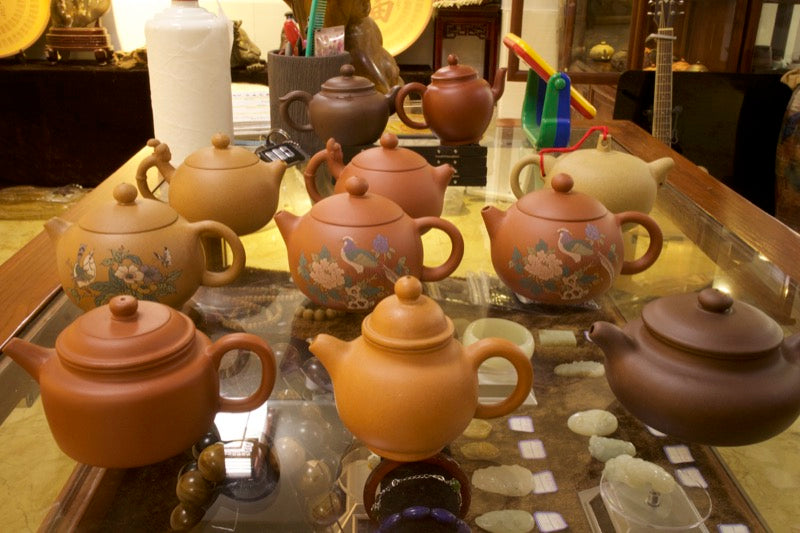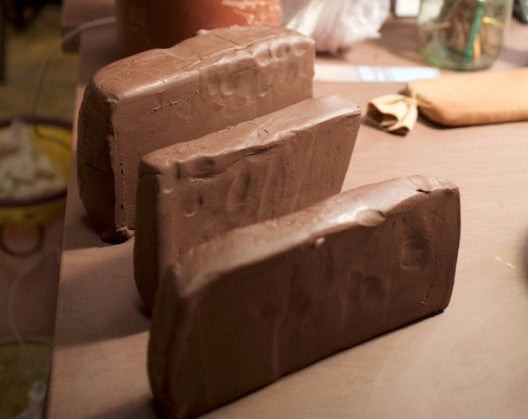The charm of Yixing teapots
Yixing, 26th April
Yixing is a wealthy and calm city on the on the west coast of the large Tai lake. The local economy is flourish; mainly thanks to the electric cable industry and environmental architecture companies. The Yixing teapots bring additional cash into the city, but just to a restricted number of persons.
I came to Yixing to purchase teapots and Yixing Hong Cha, my favorite breakfast black tea. The interpreter that assisted me two years ago is no more available; luckily I manage to find another local with even better English knowledge and a few good tea contacts.
Her aunt is a teapot maker, but she sells only to private persons. therefore prices are too high. After a short visit to her workshop, we go to a friend of her which has wider choice and price range. Here I find competence, quality and reasonable prices. So I buy ten teapots for nannuoshan and one on demand for a Swiss customer.

These are the first Yixing teapots I bought this year for Nannuoshan.
Yixing teapots are made with special clay obtained grounding stones to powder, which is then mixed with water. The Yixing clay is soft and malleable as clay, but can be fired at higher temperature. The final product is somewhat in between terracotta and porcelain. In appearance closer to stone than to standard earthenware. Dense, hard and glossy.
It’s quite easy to tell apart low and high quality materials when having enough teapots to compare to each others; they look and even sound differently. Check the video below.

Yixing teapot clay.
We drive to Dingshu, a small city near Yixing. Every second building here is a teapot shop or workshop; an area of the city is dedicated to wholesale.


Artists at work.
The choice is huge. Tens of shops one next to each other, thousands of teapots, all different. I have to follow my instinct to spot the best workshops. Most shops are messy and dark; similar to each other. One attracts my attention; it looks different. Clean, tidy and with an artistic touch. A young lady sits behind the gongfu cha table and calmly prepares tea with gentle and slow movements. I don’t know yet that she will company me for the next two days.
I like not only the teapots in her shop, but also the rest of the teaware. Beautiful plates, pitchers and tea cups. I spend the afternoon in the shop and select a teapot for a German customer who asked in advance for a particular shape, color and material.
Linxi –this the name of the lady– will pick me up tomorrow morning in the hotel.
Linxi’s gongfu cha table.
On the way back to Yixing we stop in a tea farm on the countryside. It starts raining. They produce Yixing black and green tea. The owner previously worked for a big tea factory and founded its own business just two years ago. Although he deals only with Chinese customers -no export standard needed- he uses only organic pesticides and even those only one or two times a year, in summer. This is the main reason why I actually wanted to visit him. We collect some samples for later tasting, go to dinner and then to sleep.

Tea factory on the countryside.
Yixing, 27th April
8:30am. Linxi and her boyfriend wait for me outside the hotel in her shiny Mercedes. They are both 21 years old and both their families are in the Yixing teapot business.
After breakfast we visit the shop of a friend of her, where she bought the teaware I saw yesterday in her shop. Elegant cups and gaiwans, refined stoneware tea tray. Being introduced by her, I get a strong discount; I don't miss the opportunity. I send pictures to Michela; she will review them when she gets up –it’s still night in Germany– and I will come back in the afternoon for shopping. It will be the most expensive teaware shopping ever!
There are two methods to shape a Yixing teapot, either by using a mold or completely by hand (slab-building technics). Both processes are artisanal and require time and experience.
Slab-built teapots are the most expensive and usually the best clay ores are reserved for them. Each slab-built teapot is a unique specimen, while teapots shaped with the same mold are identical.
Manufacturing a Yixing teapot in a molt and completely by hand (slab-building).
For more insight into slab-building check the video we recorded in 2014.
Back in Linxi’s shop, we have a closer look to her teapots. They are all manufactured by her family members. Her prices are fair and she seems sincere and open. I clarify not being interested in the fame of the artist, so we discard her uncle’s teapots. He is famous and therefore his teapots are most expensive. Yixing teapots have a recognized artistic value and are often purchased for collection and investment.
We then discard the teapots made of lower quality clay and those with small defects. Among those left, I select ten teapots for Nannuoshan, in two quality-price ranges; they were all shaped in the mold. Slab-built teapots made with original Yixing ore are far too expensive; and I am not keen to save on material quality just for claiming they are completely handmade. The material has a strong influence on the taste of the tea, while the manufacturing process does not. I would purchase high-quality, slab-built teapots only on demand.

Teapots purchased for Nannuoshan in Linxi's workshop.
Unfortunately I fall in love with a pear-shaped teapot; and, surprise surprise, it’s a slab-built one. I hesitate a few hours but, at the end, could not dissuade myself from buying it. Now there is a new teapot in my collection :-)
I also liked very much a tiny Japanese cups, coated with a thin layer of gold in the inner side. I don't ask the price to avoid being tempted.

One Yixing teapot more for my private collection :-)
At the end of the day we visit a few shops next door to buy some of teapots I saw yesterday. Then back in the teaware shop to purchase the teaware approved by Michela.




Shopping for Nannuoshan: Yixing teapots, Jingdezhen cups and gaiwan, glass pitcher.
Yixing, 28th April
A colleague of the mother of my interpreter knows a small tea farm in a bamboo growing area that makes no use of pesticides. They claim that in the bamboo area is not needed, but I couldn’t understand why. We go to the hospital where they work and taste the tea. Unfortunately the taste is very weak and flat; it was anyway worth a try; and an interesting experience being in a traditional Chinese medicine hospital.

Unusual tea tasting in a traditional Chinese medicine hospital.
After having sent some teaware to our warehouse in Shanghai, we visit other teashops in town to taste more Yixing Hong Cha, the local black tea.
Three kinds of black teas are produced in Yixing:
- Traditional Yixing Hong Cha: dark leaves, rather bright infusion, average body, gently and addictively aromatic.
- Short-oxidation black tea: production was started in Yixing six years ago, following the Jin Jun Mei hype. Golden in appearance, extremely aromatic and intense. Less bold and weaker in body then the traditional one.
- Ye Sheng Hong Cha (wild black tea): tea from plants naturally growing on the mountains, not cultivated by human.
I am looking for the traditional Yixing Hong Cha. Not only to restock it for Nannuoshan, but also for myself; since it is my favourite morning tea. I drink it very often in the morning and need no particular attention to recognise a good quality. So in just a few hours I taste dozens of different teas. None of them met my expectations. Even the tea of my previous supplier is disappointing. Maybe this year was no good season.
On the other end I found a best-buy short-oxidation hong cha; very cheap for its quality. I dont intend to stock it in big quantity, since we already feature Jin Jun Mei. I bought just one kilo to sell in Berlin upon request.
I also selected a wild tea that I will taste with more attention in Shanghai, where I can compare it with other teas. Wild tea is usually expensive because available in little amount and the leaves are hard to pick. I selected a late April crop, which I could not distinguish blind from an earlier tea that was almost double the price!

Three kind of Yixing Ye Sheng Hong Cha (wild black tea).

Short-oxidation, Jin Jun Mei-like Yixing Hong Cha.
After two intensive shopping days I say goodbye to Yixing, catch a a bus heading south and start writing this blog.
Written by Gabriele







